There are many rendering software that architects and designers use to work on their projects on a daily basis. Two of these famous software that we chose to talk about are Twinmotion vs Vray.
Today we are going to take a close look at both of them and see the different tools and features they offer and which one is going to better for you.
Vray

Vray is a render engine that works as a plugin that can be integrated with 3D packages such as 3ds max Sketchup, Revit, Maya, and so on. It is known for its high performance in rendering work because It gives uses unparallel levels of freedom when creating realistic textures and materials in different situations.
Lighting in Vray is a very important element since it offers the users different kinds of lighting, spots, IES lighting, dome, rectangular lights, and of course sunlight.
Vray is very popular in the design industry and also used a lot because it offers real results.
Twinmotion

Twinmotion is designed for those who want high-quality renders, animation, and panoramic pictures easily in a short period of time.
It was created to help architects, to get realistic renders, and it has a real-time engine that can be used to produce images and high-quality videos.
The Main Tools & Features
Twinmotion vs Vray

Vray is not a modeling software since it is usually integrated with a 3D modeling package for 3d modeling. It doesn’t also contain a library with objects like Twinmotion does, but it has a large variety of textures and materials that can be used to realize realistic renders. You can find any different materials for walls, wood, glass, fabric, paint, metals, and so on.
Vray is also coming with multiple types of lighting settings because the lighting is an important part of the rendering process, most used lighting objects in Vray are the sun, rectangle light, SPOT light, and IES light, it is also possible to change the color of the light, the intensity, the size, and the result of these changes also relate to the surfaces and textures in the project.
It is also possible to change materials and apply different settings in Vray. There are a lot of parameters relative to the materials, it is possible to change the color of the material, the reflection, the refraction, the opacity of the material, and the dump mapping. This plugin is also equipped with tools and parameters, which can be controlled to generate more realistic renders, like global illumination, caustics, atmosphere, Z depth, and so on.
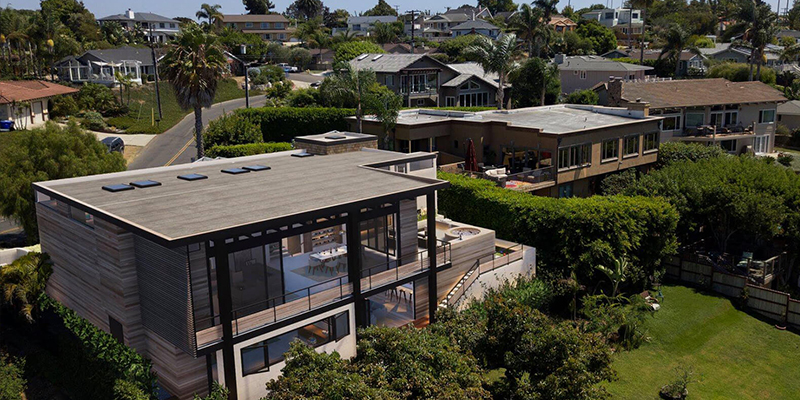
Twinmotion is made for rendering purposes only, and it is compatible with multiple modeling software in the market like Revit, Sketch-up, Archicad, and Rhino which means that Twinmotion and the modeling software are synchronized together and any modification on the model will appear directly on Twinmotion. The software has a great library full of assets, like interior and external furniture, vegetation, people, animals…etc., it also has a physically based sky and sun model, these two options were added recently to the software, it also has a new feature for the volumetric light tool, and screen space global illumination.
With its virtual reality features, Twinmotion allows you to walk around the project and check it from different angles, it also has a lot of smart assets that can be added which add life to the project like rain sound, vehicles sound, wind, photo scanned humans, motion-captured animations and you can also add a skyline as background for the urban rendering or city rendering projects.
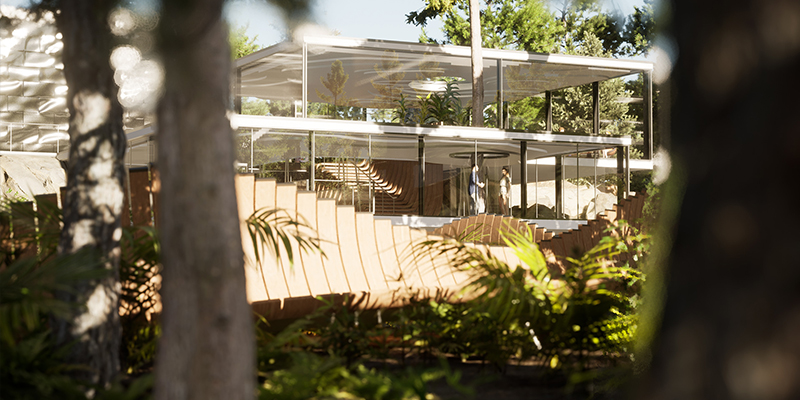
In Twinmotion it is also possible to add the geographic location of your project; it is possible through downloading real context from an open street map.
Another great thing about this software is its real-time capabilities which are also available in Vray as well but in the same way; it is a must-have option in any rendering software to make the work of designers and architects easier and to gain time. This is better than doing a rendering test every time to see if everything is well configured. It is also a great way to see if all the materials and lighting are in harmony before launching the render especially when rendering animations.
The new version of Twinmotion has a lot of new features like interactive parametric doors that can fit automatically to the size of the opening, realistic water material to reflect changes in depth, and to get better rendering results. The software is also equipped now with a larger library of vegetation and a lot of new different plants, this is something I found to be interesting compared to the other rendering software of this type because it is just great if your scenes contain a lot of plants and trees.
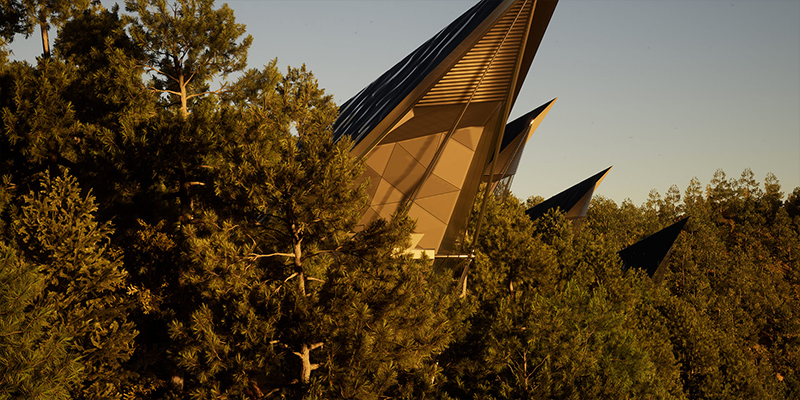
Vegetation scattering in Twinmotion is a great new tool used to draw vegetation and grass using a brush, it is a great quick tool especially for big urban projects or projects with a garden.
In addition to that, Twinmotion developers added a new feature which is animated objects that enable you to link any object to a rotation or translation widget to animate customized objects like windows and doors.
Rendering and animation
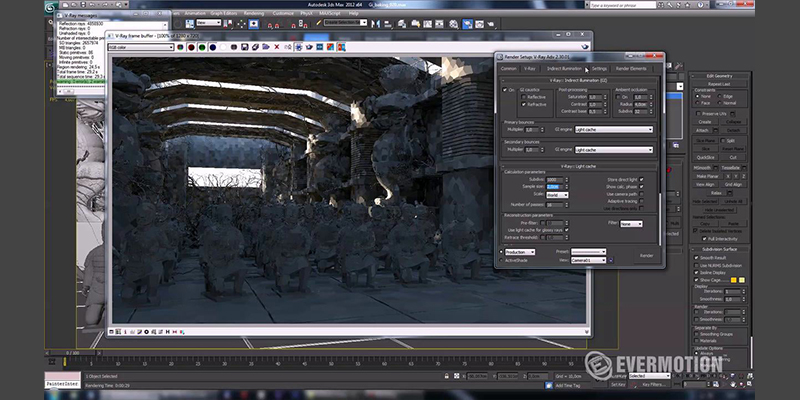
Vray is a very strong rendering engine compared to Twinmotion, the quality of the renders can be incredibly realistic. It is also equipped with a treatment option for pictures, to edit the light and the contrast, and the balance of the colors without the need to take the picture into another software. As for the animation, it is possible to render different types of animations from house tours to complex animated cinematic shots, but it is not as straightforward as Twinmotion is because the animation is done using the 3D package used with Vray.
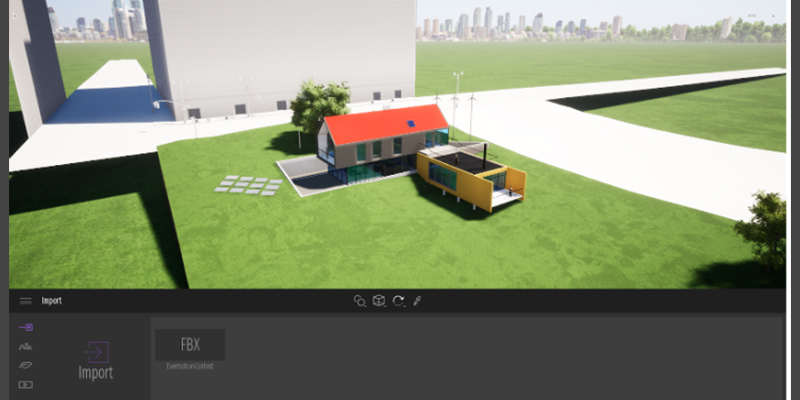
Twinmotion also allows high-quality renders, realistic vegetation, and even the smallest details are visible in the render, the company pays a lot of intention to this point, and its improvement is obvious in the latest versions of the software. It also offers the animation and panoramic pictures option, which is great especially for architects to be able to present their projects to clients in a different format, the animation configuration is easy and any beginners can learn how to do it easily.
Freedom & Flexibility

Before rendering in Vray you have multiple settings at your disposal, it is possible to choose to render using the CPU or GPU, the quality of the render from low to high, and it is also possible to activate the denoising options. You can also specify the type of camera whether it be a standard VR spherical panorama or a VR cube map. You can also change the exposure value which is relative to the sensitivity of the camera to the light. Besides that, you can also activate the depth of field and specify the resolution of the picture and its format. It is also possible to add a background if the render is in an exterior scene.

On the other side, Twinmotion also comes with a lot of settings to customize the work and the project as a whole; a user can control the sun direction and time, manage the light and shadows, control the camera’s sensitivity to the light (exposure) for more realistic renders. Twinmotion is equipped also with multiple settings for realistic vegetation where you can control the growth and the high of grass, choose the season and the age of the plants and they will actually be manifested according to the selected age and the season that you have chosen.
Overall, Twinmotion is great for rendering because it has many settings but Vray is just way more flexible and is used in a lot more different settings that can help you work on different projects whether it be Archviz, design, animation, VFX, and so on.
So, in terms of flexibility Twinmotion is good in design and Archviz but Vray is just way more flexible but the ease of use of Twinmotion and the library of assets and the controls it offers makes it great.
Industries that Use Twinmotion vs Vray

Vray is used in the design industry, like interior design, furniture design, and architectural rendering in addition to Vfx projects, animations, and Commercials.
Twinmotion is basically used by Architects, Designers, and Landscape Architects; it is made to do all the work related to the construction industry.
Computer Requirements

Twinmotion is software that can run into a medium-performance computer, but if you are looking for a quick and smooth workflow, it is better to use a workstation especially when working on big urban projects.
Vray, too, can run on an average machine but the workflow will be slow, and the rendering will take more time, besides that the results won’t be realistic if you don’t the renders their proper time, so it is better to use a high-performance computer for a quick workflow and better results.
Learning Curve

Vray is relatively easy to learn; if you are a beginner you don’t necessarily have to mess with a lot of configurations and settings because Vray is more user-friendly using ready presets. It can be used by students, beginner designers, and so on, but I would say it is better suited for professionals looking for more freedom and flexibility in their work.
The community of Vray is huge because this plugin has been around since 1997, so you will find a lot of tutorials and professional courses that will teach everything you need to know.
Twinmotion is also an easy software to use; the interface is simple and the tools are easy to understand. it is a good software to start within the design industry, the official site of the software offers tutorials and articles to answer user’s questions and also to give recommendations and to explain all the new features in the latest versions.
Pricing and OS

Vray is available on both MAC and Windows; its pricing is 350 US dollars per year with free support and unlimited access to all future releases and updates. You can also get the Vray collection for 699 US dollars per year; this collection contains 15 products including Vray, Phoenix FD, Project Lavina, and Chaos cloud, this offer comes also with free support and unlimited access to all future releases and updates.
Twinmotion is available on MAC and Windows for 499 US dollars per year, which is not very expensive compared to Vray, the software supports a lot of modeling software so it is highly available to make designer’s life much easy. Epic The company that owns Twinmtion also offers from time to time good deals to gain more clients and to have more visibility in the market.































